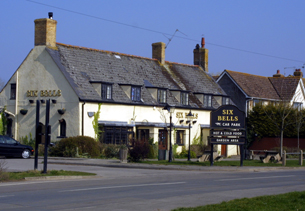Historic Landscape
Characterisation
The Gwent Levels
17 Peterstone
17 Peterstone character area: "regular landscape"
of Roman date.
(Photo: GGAT Gwent Levels 096)
Click here for a character area map
Archaeological investigations at Rumney Great Wharf, south of Newton Farm in Rumney, have established a Roman date for the laying out of this landscape. Drainage was probably undertaken by Roman legionaries based at Caerleon.
Recolonisation of the area in the high medieval period led to the establishment of Peterstone village and settlement along Broadstreet Common. The sea wall was moved back in the late medieval period.
Peterstone was owned by St. Augustine's Abbey in Bristol, and this association has found its way into local tradition.
Key historic landscape characteristics
Regular landscape of trapezoidal blocks of very long, narrow fields
dominate (of Roman origin?) street commons (some with farms of medieval
origin), drainage features including reens, ditches and grips, seawall
(set back)
This landscape occupies the central part of the Wentlooge Level, extending from the higher coastal zone through to the low-lying back-fen. Areas 16 and 21 lie to the east of Broadway Reen. Areas 8/19 lie to the north/west.
This landscape is characterised by trapezoidal blocks of very long, very narrow fields. Several major axial elements include Broadstreet Common, a fine example of an unenclosed street common with farmsteads along its edge set back from the road. The sea wall cuts unconformably across the landscape, and the lines of field ditches can be seen cut into the intertidal peat shelf. There is excellent grip survival.
As a surviving example of large-scale Roman reclamation, it is certainly unique in Wales, if not north-west Europe. The homogeneity of large areas, laid out in exceptionally long narrow fields, contrasts with the complex landscape along Broadstreet, where farms of medieval origin are strung out along an unenclosed street common.
The area around Peterstone village, and along Broadstreet Common is fairly wooded. Otherwise, the character area presents quite an open landscape, with many field ditches filled with reeds rather than having hedges. Many areas retain a very strong feeling of a landscape comprised of long narrow fields.
Overall, this landscape is of enormous importance, retaining a high degree
of integrity and coherence. On the whole it is in fine condition, having
escaped large-scale agricultural improvement. The sea wall affords very
good views, though industrial development to the west and urban sprawl
to the north does impinge.
